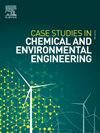微波辅助合成用于废水净化的杂化材料“海芋藻-纳米铜”
Q1 Environmental Science
Case Studies in Chemical and Environmental Engineering
Pub Date : 2025-09-12
DOI:10.1016/j.cscee.2025.101280
引用次数: 0
摘要
纺织和相关工业释放的合成染料由于其持久性、毒性和对传统处理方法的抗性而成为水污染的主要来源,因此开发可持续和高效的生物吸附剂是废水处理的关键挑战。在这项研究中,干燥的Posidonia Oceanica (P.O)生物质首次用于微波辅助合成含铜(1%,2%和4% Cu2+)的杂化材料,为传统方法提供了一种快速,节能,无溶剂的替代方法。该技术提高了化学产量和反应控制,同时最大限度地减少了对环境的影响。采用零电荷法(pHpzc)和Boehm滴定法测定表面酸碱度,对原料和改性P.O纤维进行了表征。利用红外光谱(FTIR)、扫描电镜(SEM)、能量色散x射线能谱(EDX)和x射线光电子能谱(XPS)进行了进一步的结构和形态分析,证实了Cu - oh、Cu - o - c和Cu(COOH)2键的形成以及表面碱性位点的增加。通过对水溶液中甲基橙(MO)的去除,评价了材料的吸附性能。生P.O的生物吸附量从0.768 mg g−1增加到P.O- 4% Cu2+的0.981 mg g−1。考察了影响吸附的重要因素。0.01 M EDTA预洗降低了NaCl的干扰,从而提高了MO的去除率。增加吸附剂质量可提高染料吸附性;而较高的温度稍微改善了吸附,表明吸热过程轻微。采用拟一阶、拟二阶和Brouers-Sotolongo (n = 2)模型进行动力学建模表明,Brouers-Sotolongo模型最能描述该过程,且具有较高的保留率和均匀性(α = 1; ζc = 2.51 min)。可回收性试验表明,用HCl + NaCl再生三次后,p.o - 4% Cu2+的吸附容量仍保持92%,表明其具有重复利用的潜力。这些结果表明,微波辅助Cu2+改性显著提高了P.O纤维的生物吸附性能,使其成为废水处理中有前途的、可持续的生物吸附剂。本文章由计算机程序翻译,如有差异,请以英文原文为准。

Microwave-assisted synthesis of hybrid materials "Posidonia oceanica-copper nanoparticles" for wastewater purification
Synthetic dyes released by the textile and related industries are a major source of water pollution due to their persistence, toxicity, and resistance to conventional treatment methods The development of sustainable and efficient biosorbents therefore represents a key challenge in wastewater treatment. In this study, dried Posidonia Oceanica (P.O) biomass was used for the first time in the microwave-assisted synthesis of hybrid materials functionalized with copper (1 %, 2 %, and 4 % Cu2+), offering a rapid, energy-efficient, and solvent-free alternative to conventional methods. This technique enhances chemical yield and reaction control while minimizing environmental impact. The raw and modified P.O fibers were characterized using zero point of charge (pHpzc) and Boehm titration to determine surface acidity/basicity. Further structural and morphological analyses were conducted using infrared spectroscopy (FTIR), scanning electron microscopy (SEM), energy-dispersive X-ray spectroscopy (EDX), and X-ray photoelectron spectroscopy (XPS), confirming the formation of Cu–OH, Cu–O–C, and Cu(COOH)2 bonds and an increase in basic surface sites. The materials' adsorption performance was assessed by removing methyl orange (MO) from aqueous solutions. Biosorption capacity increased from 0.768 mg g−1 for raw P.O to 0.981 mg g−1 for P.O-4 % Cu2+. Important factors influencing adsorption were examined. Prewashing with 0.01 M EDTA reduced NaCl interference, thereby enhancing MO removal. Increasing the adsorbent mass improved dye uptake; while higher temperature slightly improved adsorption, indicating a slightly endothermic process. Kinetic modeling using pseudo-first-order, pseudo-second-order, and Brouers–Sotolongo (n = 2) models indicated that the Brouers–Sotolongo model best described the process, with improved retention rates and homogeneity (α = 1; ζc = 2.51 min). Recyclability tests demonstrated that P.O-4 % Cu2+ retained 92 % of its adsorption capacity after three cycles when regenerated with HCl + NaCl, highlighting its potential for reuse. These results demonstrate that microwave-assisted Cu2+ modification significantly enhances the biosorption properties of P.O fibers, making them promising, sustainable biosorbents for dye removal in wastewater treatment applications.
求助全文
通过发布文献求助,成功后即可免费获取论文全文。
去求助
来源期刊

Case Studies in Chemical and Environmental Engineering
Engineering-Engineering (miscellaneous)
CiteScore
9.20
自引率
0.00%
发文量
103
审稿时长
40 days
 求助内容:
求助内容: 应助结果提醒方式:
应助结果提醒方式:


